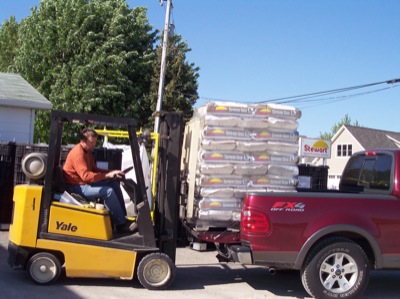Wednesday, May 28th, 2008
Local farmers face extra costs due to weather
By Shelley Grieshop

Photo by Betty Lawrence/The Daily Standard
Ken Lange, warehouse manager at Stewart Seeds of rural Celina, fills a truck bed with a load of soybean seeds. He has been extra busy the past few days, supplying farmers with seed as many are replanting their crops.
The rain that didn't arrive as predicted Memorial Day weekend has sent many farmers back into their fields to replant corn and beans.
Local agriculture experts say farmers were hoping the forecasted rain would soften the surface of the soil to allow recently-planted seedlings to emerge. Unfortunately, the rain didn't come. To make matters worse, seeds are scarce this year and planting costs are at a record high, says a local seed dealer.
"This is the worst I've ever seen," said Steve Knapke of Helena Agronomic Center, Coldwater, who's been in the seed business for 30 years.
Replanting might not be profitable either, he said. Fuel prices keep rising; fertilizer is nearly 200 percent more than last year; and seeds - if you can find them - carry a price tag 15-20 percent higher than last spring.
Depending on the market price at harvest time, a farmer's extra time in the field could be in vain, Knapke explained.
"I almost guarantee that about every farmer out there is at least spot planting if not replanting their entire field," Knapke said, basing his statement on recent seed sales.
Most area farmers first planted three weeks ago, and it typically takes a week or two before the seed germinates and pops through the ground. The longer a seed remains in the ground, the more at risk it is to decay, mold and pests.
A good rain fell about the time many farmers planted their crops the first week of May, but the cool and dry weather that followed has created a hard crust on the soil, making it difficult for seeds to sprout.
"That crust is like concrete," Knapke said.
Because the corn and soybeans harvested last year were dry and fragile, quality seeds for this year's crop are hard to find and subsequently costly. Knapke said he's been able to please most of his customers, so far, but it hasn't been easy. Farmers want to replace their first plantings with seeds of the same traits and maturity, he added.
Todd Mangen of the Ohio State University Extension Office in Celina said some farmers have been "rotary hoeing" to try and break up the top soil but it overall hasn't been real successful.
"It's (the soil) still too hard, though, and I don't think it's doing much good," he said.
Despite the possibility of a poor harvest, Mangen warns area farmers to think twice before replanting. "Stand counts" - a practice that involves counting the number of plants in a specific measured area - is one way farmers can tell whether their crop growth is adequate, Mangen said.
A chance of showers is forecasted for Friday and Saturday, which could help some farmers who are still holding out hope for their initial planting.
"Farmers have to be the most optimistic people out there," Knapke said. "They have to have hope. It's their life."

